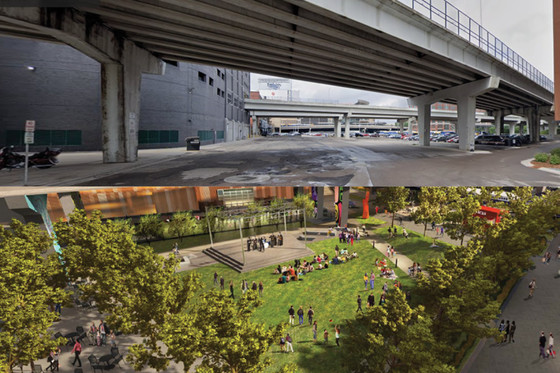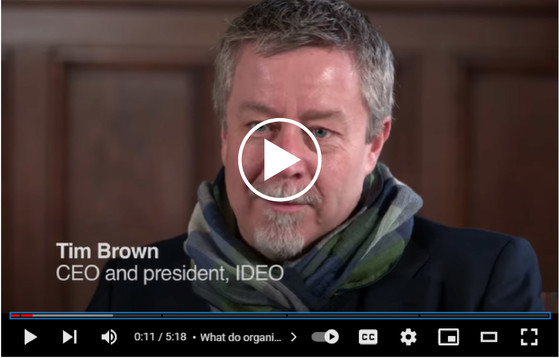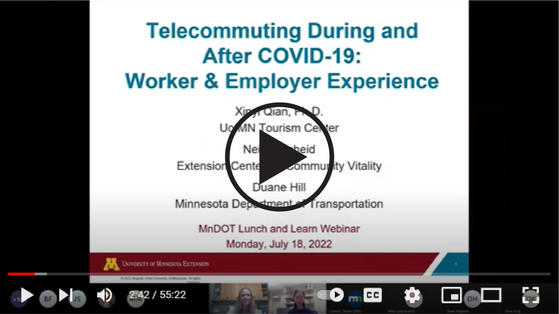MnDOT Innovation Focus
Issue 7 – August 2022


By Katie Walker, MnDOT Research & Innovation Director
“If you want to innovate, you have to take risks, and to take risks, you have to have some level of trust in the organization.” Tim Brown, CEO and President, IDEO - YouTube
Risk taking and trust building have been put into practice this summer at MnDOT. During May-June, eighteen participants representing twelve MnDOT Offices and Departments participated in a process which resulted in the generation of over 180 ideas about how MnDOT might implement innovation within four key areas: Communications; Recognition and Reward; Developing an Innovation Pipeline and Portfolio; and, Professional Development and Training. As groups explored the possibilities, feasibilities, and challenges that go with developing a culture of innovation, members took risks, built as well as noted the importance of trust, and identified starting places in each of the four areas. In the months ahead, the Office of Research & Innovation will be reaching out to key partners to build upon the connections that were made and the ideas that were shared for how MnDOT can implement innovation.
Strategically examining the future needs of the transportation sector using the three core tenants of the innovation mindset – empathy, experimentation and empowerment – was also recently put into practice by MnDOT’s Senior Leadership Team (SLT). In June, the SLT had a retreat that included an interactive session focused on the future-of-work initiatives and supporting employees work and well-being. During this experiential session, participants harnessed the power of their empathy to explore MnDOT’s future, and the ways we as individuals and teams may best organize our work and time.
Lastly, Minnesota continues to be a connected leader in innovation, and I’m honored to be selected as vice-chair of AASHTO’s Innovation Community of Practice, a state-led peer group with representatives from across the US. This opportunity will enable me to share the great work happening at MnDOT and bring back learnings from fellow DOTs.
|
Minneapolis Public Space Opening 2024 via MnDOT Airspace Agreement
 By Jessica Oh, MnDOT Strategic Partnerships Director
A new public space, North Loop Green, will be joining Minneapolis’ North Loop neighborhood in 2024.
The new public space located in a MnDOT right of way will be adjacent to two towers of mixed-use development, adjacent to Target Field. The plaza will feature a highly activated green space that will be programmed year-round with a wide range of artistic, cultural, and community-based events for locals and visitors to enjoy such as outdoor movie nights, live performances, and seasonal festivals. Amenities will include a dog exercise area, outdoor exercise equipment, garden, and food and beverage vendors.
Designed as a transit-oriented space, the development and plaza will serve as a mobility hub—located in close proximity to the Northstar Line, Cedar Lake Trail, and ABC Ramps. Additionally, there will be 225 bicycle parking spaces to support active transportation.
MnDOT’s Offices of Land Management, Sustainability and Public Health, and Chief Counsel collaborated closely with the developer, city and project planners for three years to execute the agency’s first-ever public space pilot that includes commercial uses. During the 30-year airspace lease, developer Hines will invest $5 million in public space improvements and perform operations and maintenance of the site.
Temporary Outdoor Dining Permits during the pandemic (Executive Order #20-70) paved the way for MnDOT to develop a new section in the Right of Way Manual to allow limited commercial use of MnDOT-owned land through airspace leases.
Nationally, there has been a growing movement to reclaim underutilized transportation infrastructure and reimagine it as a public space, such as:
North Loop Green is an exciting initial pilot as MnDOT explores new types of non-transportation uses of right of ways that align with the agency’s statewide planning goals. MnDOT is increasingly exploring these Alternative Uses of Right of Way projects that support public health, sustainability, economic development and quality of life through public-private partnerships through MnDOT’s Center for Community Connections and the Strategic Partnerships Program.
Roadside Safe Spaces for Butterflies and Bees

By Julie Swiler, MnDOT Research & Innovation
Pollinators such as rusty-patched bumble bees and monarch butterflies, critical to our eco-system, are at risk due to the loss of native habitat. A University of Minnesota research team, with support of MnDOT and the Local Road Research Board, studied whether restored roadsides could provide safe habitats for declining pollinator populations.
The researchers began by determining where pollinator-friendly habitats should be prioritized, what plant communities are created by current revegetation practices, and how pollinators use them.
They evaluated a pollinator-friendly mapping tool, which was positively associated with bumblebees, that could be refined to target specific species. This could help prioritize the stretches of road that would be cost effective to be enhanced, since native plant seed mixes can be more expensive than non-native plantings.
They also sought to understand how well native and non-native seed mixes establish in the compacted and chemically unique soils of roadsides. They revisited roadside sites that had been seeded with native versus non-native seed mixes to collect data on plant and pollinator communities 2-20 years after planting.
Seeding with native plants works – these sites had a significantly higher number of native flowering plants than sites seeded with non-natives. The team found that pollinator abundance in roadsides was related primarily to flowering plant abundance, regardless of whether plants were native. Still, the diversity of pollinator communities was positively related to the diversity of the flowering plant community.
However, the effect of seeding is short lived. The plant community is similar between native and non-native sites a few years after seeding, as seeded plants dwindle, and invasive plants become more common. This finding presents an opportunity to experiment with maintenance practices to see if long-term outcomes can be improved at sites seeded with native plants.
For more information, visit Cost-Effective Roadside Vegetation Methods to Support Insect Pollinators.
|
Improving Information Access, Chief Counsel and MnIT Launch Data Practices Request Portal

By Josh Root and Eric Bell, MnDOT Chief Counsel
DYK? Everyone has the right to request information from the government.
MnDOT receives over 1,000 data requests each year. That number is growing annually and is expected to top 1,500 this year.
Who is submitting these requests? While anyone can make a request, the most frequent requesters are law firms, insurance companies, media outlets, labor unions, and other governmental organizations.
Historically, requesters would contact the Office of Chief Counsel using several different channels, including phone, mail, or email. MnDOT’s data practices coordinator would then manually process each request and filter them to their respective topic areas. The process was time consuming, inefficient, and challenging to track.
To streamline the process for both customers and staff, Chief Counsel partnered with MnIT to develop a new centralized portal for requests, using Salesforce. The form is quick and easy to complete, building customer trust and increasing transparency. For the agency, this software automates various aspects of the process, which allows staff to better manage their workflow, track metrics, and maintain data.
“This collaborative effort was a success—leveraging technology to centralize and automate MnDOT’s data practice response process,” said Wendy Surprise, MnDOT data practices coordinator. “Our goal is for the public to easily access the information they need.”
|
How do you build a culture of innovation?
 How does a successful company maintain a climate in which new ideas and risk-taking are encouraged? In this video, Tim Brown, CEO and president of the design consultancy IDEO, describes how he thinks about innovation and why empathy is an important part of the equation.
ICYMI: Telecommuting During COVID-19
 A new study from Minnesota Department of Transportation and University of Minnesota offers the most comprehensive look known to-date of how telecommuting in Minnesota has changed since the COVID-19 pandemic began, with survey data from more than 1,200 Minnesotans and employers. MnDOT’s Office of Research & Innovation hosted a Lunch & Learn on July 18 featuring the recently completed research study, “Telecommuting During COVID-19: How Does It Shape the Future Workplace and Workforce?”
Minnesota Digital Government Summit
Mark your calendar! Government Technology is hosting the Digital Government Summit on August 11. The event provides attendees with a chance to share ideas and learn how we can apply our new perspectives to the expectations that Minnesotans have to digitally interact with government. Be sure to attend the Bits & Bytes - The Smart Future is Here session at 10:10 a.m. to hear about MnDOT's smart community endeavors.
|